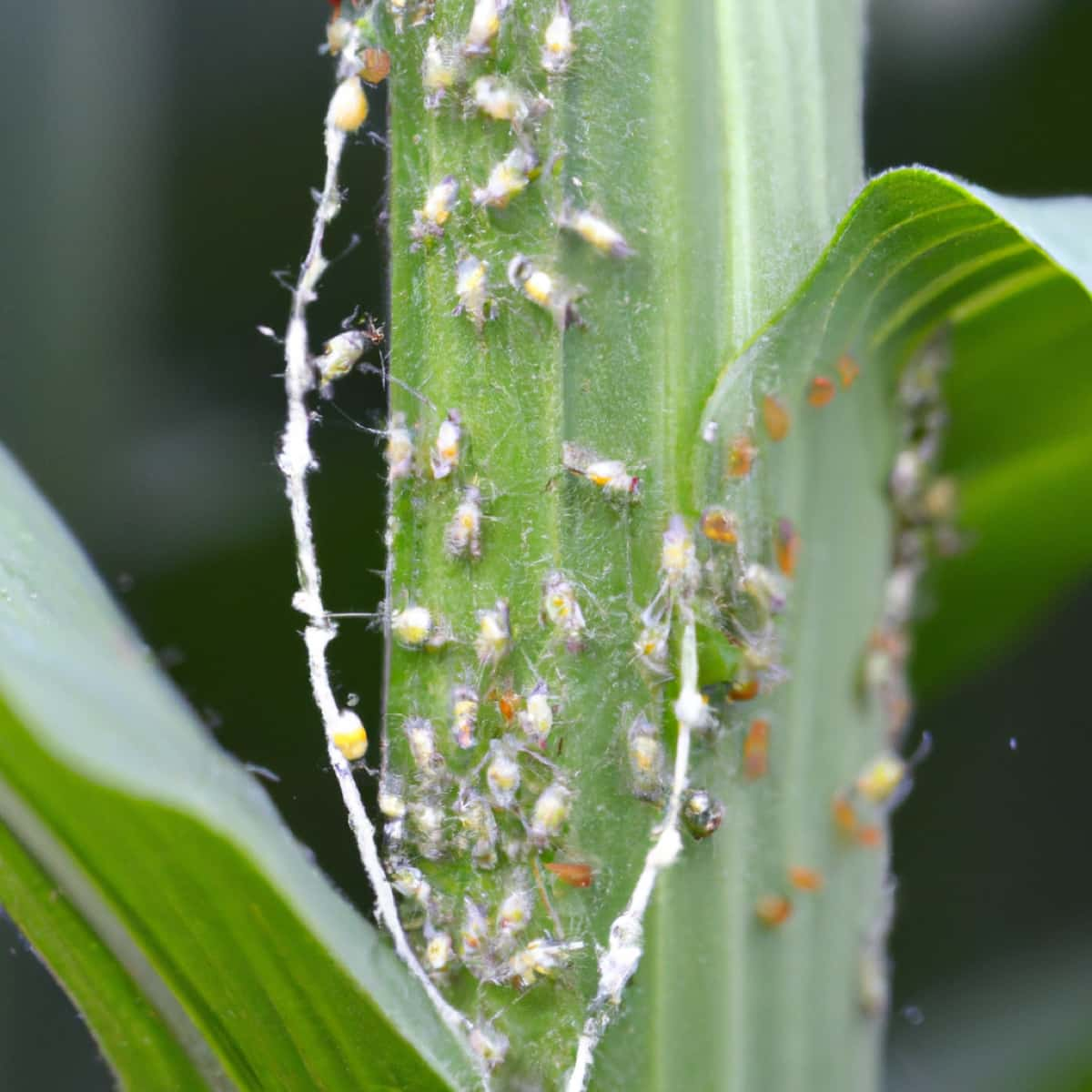The Maize Aphid, Rhopalosiphum maidis, belonging to the Family Aphididae of the Order Hemiptera, is also known as the Corn Plant Lice. It is a small, yellowish-green sap-sucking insect that feeds on the sap of the maize plant, resulting in significant yield losses. Maize aphids can also act as a vector for plant viruses, which can cause further yield losses. It can reproduce rapidly, making it difficult to eradicate. Effective management of the maize aphid is essential for protecting maize yields and preventing economic losses.

Control measures for the maize aphid include chemical sprays, biological control agents, and cultural practices. To effectively manage this pest, it is important to understand its life cycle, its preferred habitats, and the best methods for controlling it. This article will provide an overview and discussion of the Maize Aphid Pest in Maize crops, including its symptoms, identification techniques, and control.
Maize Aphids Pest Management
Life Cycle of Maize Aphid Pest in Maize Crop
Egg: The egg stage is the initial stage of the life cycle, which occurs for five to seven days. The female adult aphid lays the eggs on the underside of the leaves. After five to seven days, the eggs hatch into nymphs.
Nymph: The newly hatched nymphs feed on the plant’s sap. They increase in size and molt four times. As they feed, they excrete a sugary substance called honeydew, which can cause fungal growth in the maize plants. The nymphs also reproduce through reproduction at this stage.
Adult: The adult stage is the third stage of the life cycle. Adult aphids are winged and can fly from one location to another. They feed on the sap of the maize plants and lay their eggs on the underside of the leaves, and can reproduce.
Mating: The mating stage is the fourth stage of the life cycle of maize aphids. During this stage, the male and female aphids mate, the female lays eggs, and the cycle begins again. The life cycle of the maize aphid is completed in three to five weeks.
Occurrence of Maize Aphid Pest in Maize Crop
- Location of maize Aphid pest: This pest is native to North America and is found to infest the maize crops in the US, Mexico, Canada, Costa Rica, Africa, the UK, Germany, France, Italy, India, Bangladesh, China, Japan, South Korea and Taiwan and Australia.
- Host range: The primary host of the pest is maize crops, but it can also feed on other cereals such as wheat, sorghum, barley, ragi, oats, cabbage, broccoli, tomatoes, and peppers.
Factors Favoring the Population Increase of Maize Aphid Pest in Maize Crop
- Temperature – Maize aphids prefer warm temperatures and thrive in temperatures ranging from 24 to 30°C, increasing their reproductive rate.
- Rainfall – Maize aphids require adequate moisture for successful reproduction. High levels of rainfall create a favorable environment.
- Cropping System – Maize monoculture cropping system is more prone to aphid infestations than rotation cropping systems.
- Cultural Practices – Poor crop management practices, such as delayed planting and inadequate weed control, can create favorable conditions for the pest.
In case you missed it: Maize Web Worm Pest Management: Symptoms, Treatment, Chemical, Biological, Natural, and Organic Control

Identification of Maize Aphid Pest in Maize Crop
- Egg: The eggs are yellowish-white in color, oval, laid in clusters of up to 40 eggs per cluster, and attached to the underside of the leaf surface.
- Nymph: The nymphs are light green-yellow, have short antennae legs, and can be seen with the naked eye.
- Adult: The maize aphid can be identified by its white or yellowish-green body color, long antennae, dark green legs, wings, and small size. But the reproductive adults are larger than adults, black with longer antennae and legs.
Damage Symptoms of Maize Aphid Pest in Maize Crop
- Maize aphids feed on the sap of maize plants, and their presence can cause yellowish mottling in leaves, marginal leaf necrosis, stunted growth, malformed ears and kernels, and reduced yields.
- They also secrete a sticky substance called honeydew, which can attract other pests, such as ants and sooty mold. This honeydew may hamper harvesting in panicles.
- During the flowering stage of the crop, the Maize Aphid pest feeds on the pollen, causing the kernels to be malformed.
- Aphid colonies are observed in the central leaf whorl, stems, and panicles. These aphids can potentially transmit the maize dwarf mosaic virus in the crops.
- The galls are caused by the aphids injecting a toxin into the stems and leaves of the maize plants, which can cause the stems and leaves to swell and form galls.
Percentage of Yield Loss in Maize due to Maize Aphid Pest
In Mexico, maize aphids can cause yield losses of up to 30%. In the United States, there are 5-15% yield losses. In Canada, yield losses of up to 25% occurred. In India, yield losses of up to 50% are witnessed. In Tanzania, yield losses are up to 40%. In the Philippines, yield losses of up to 20% are seen. In South Africa, yield losses are up to 25%. The ETL of maize aphid pest is set between 5-10% infestation.
Cultural Control of Maize Aphid Pest in Maize Crop
- Sanitation – This includes removing crop residues and weeds, which provide a favorable environment for the pest. It also includes removing infested plants to reduce the spread of the infestation.
- Good cultural practices – These include the proper selection and rotation of maize varieties, appropriate planting and management techniques, and removal of infested plants.
- Traps – Traps can also reduce the population of maize aphids. The pheromone traps attract adult insects and capture them before they can lay eggs on the crop.
Biological Control of Maize Aphid Pest in Maize Crop
- Parasites – The most used biological control agents are the parasitic wasps, Aphidius colemani and Aphidius matricariae. These wasps parasitize the aphids by laying their eggs inside the aphid body. When the wasp’s eggs hatch, the larvae feed on the aphid and kill it. These wasps can reduce the pest population by up to 90%.
- Predators – The predatory bug, Orius insidiosus, feeds on aphid eggs, larvae, and adults, thus reducing the pest population. This bug can reduce their population by up to 70%.
- Pathogens – The fungus ‘Entomophaga maimaiga’ is highly contagious and infects the maize aphids, causing them to die. This fungus can reduce its population by up to 90%.
Chemical Control of Maize Aphid Pest in Maize Crop
- Mix 500 ml of Dimethoate 30 EC or Methyl demeton 25 EC in 500 Liters of water and apply the mixture on the plant as a foliar spray using a knapsack sprayer.
- Spraying should be done when the aphids are present, in the early morning or late evening when the aphids are most active.
- Systemic Insecticides can also be applied as a soil drench. The insecticides are taken up by the roots and move through the vascular system, killing any aphids that may be present.
Preventive Measures for Control of Maize Aphid Pest in Maize Crop
- Intercropping maize crops with other crops, such as beans and cowpeas, helps to reduce the population of maize aphids.
- Neem oil is a botanical insecticide that is effective against maize aphids. The oil can be mixed with water and sprayed on the crop.
- Predators such as ladybird beetles, lacewings, and hoverflies feed on aphids, and hence they help control the pest population.
- Traps can be used for monitoring the population of maize aphids. Yellow sticky traps are the most commonly used traps for monitoring the population of maize aphids.
In case you missed it: Maize/Corn Ear Worm Pest Management: Symptoms, Treatment, Chemical, Biological, Natural, and Organic Control

Conclusion
The maize aphid is a major pest of maize crops, causing serious economic losses due to its voracious feeding habits, ability to spread plant diseases, the destruction of foliage, reduction in grain production, and increased costs for insecticides. However, with integrated pest management strategies, the risk of damage from maize aphids can be minimized. Farmers can use cultural, mechanical, and chemical control to protect their crops from this damaging pest.
- Deworming Schedule for Dogs/Puppies: A Beginners Guide
- How to Prevent and Control Parasites in Goats
- Beneficial Insects in Pest Management
- Natural Solutions for Pest Control in Flower Gardens
- Types of Fungicides Used in Agriculture
- Common Issues in the Fruit Development Stage of Pomegranate Farming
- Fruit Development Issues in Papaya: Easy Solutions and Treatment
- Soil-Borne Diseases and How to Protect Your Plants
- Practices to Prevent Disease Spread in the Garden
Thank you very much for the post. Very informative.